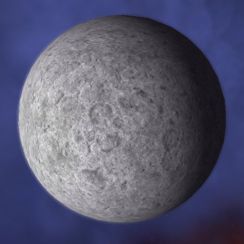Ashington
| Ashington | |
| Location | 5D, Newcastle |
| Technical information | |
| Docking | No |
| Terrain | Barren |
| Diameter | 4,216 km |
| Mass | 2,26 x 10e24 kg |
| Temperature | -105°C to 91°C |
| Escape velocity | 3,72 km/sec |
A small, pock marked moon of the Planet Carlisle, Ashington has reasonable amounts of Gold deposits located near its south pole, but besides the small automated mining installations placed there by the BMM, there has been no interest in the Planetoid whatsoever.
Research done by the Cambridge Stellar Research
- Disclaimer: This is not canon lore. This is purely created out of in-game and Forum RP
From orbit, Ashington looks like an average barren moon without atmosphere and numerous craters scarring it's surface - hence, though Bretonia Mining&Minerals have set up an automated mining operation near the south pole mining Gold, but the operation didn't live up to expectations, and hence the planetoid was largely lacking interest whatsoever. However, this situation changed when a then-forming independent scientific organisation, the Cambridge Stellar Research have decided to explore the moon in early 818 A.S. The Ashington environment is unfriendly at best - without even traces of atmosphere and the moon being tidally locked to Carlisle, there is a huge difference of temperatures between the moon's day and night side. Furthermore, the moon hence orbits in a way where the self-axis rotation time and Carlisle's axis rotation time are equal, thus causing monthly solar eclipses on Carlisle.
The moon's most notable landmark are two enormous, identical impact craters on the moon's night side, nicknamed Devil's Eyes by the CSR scientists. Their stunning scenery, and similarity caught the attention of the research group, and upon landing in the craters, they've found that both craters were the result of a single stellar body colliding with the moon at a very low angle, and then breaking apart. Further investigation of the impact holes and the surrounding terrain have, however revealed the moon's early geographical history to be much more uncommon than originally thought.
According to the theory supported by the evidence found at the craters, the moon was originally a planet itself, orbiting the Newcastle sun at a close orbit, with a rich atmosphere which in turn allowed primitive life forms on the planet, such as bacteria and even invertebrae. This came to an end, however when Ashington collided with an unusually large asteroid, orbiting ellipticaly around the sun - it was a one in a million chance, but the impact was so huge, that it extruded Ashington from it's orbit, creating a huge field of debris floating around it and slowly ripping it from it's atmosphere. The asteroid fell into two, creating the Devil's Eyes, while Ashington floated outwards from the sun until being caught in the gravitational well of Carlisle. However, not all life forms died with the atmosphere - some exteremly resistant bacteria have managed to survive on the debris chunks, and upon arriving at the then still forming Carlisle, they quickly adopted - hence, current Carlisle lifeforms actually are originating from Ashington due to panspermia.
